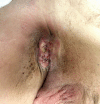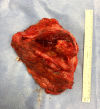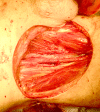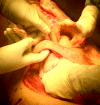Complex Reconstruction with Flaps After Abdominoperineal Resection and Groin Dissection for Anal Squamous Cell Carcinoma: A Difficult Case Involving Many Specialities
- PMID: 29339717
- PMCID: PMC5782837
- DOI: 10.12659/ajcr.906818
Complex Reconstruction with Flaps After Abdominoperineal Resection and Groin Dissection for Anal Squamous Cell Carcinoma: A Difficult Case Involving Many Specialities
Abstract
BACKGROUND Anal squamous cell carcinoma accounts for about 2-4% of all lower gastrointestinal malignancies, with a distant disease reported in less than 5%. Although surgical treatment is rarely necessary, this often involve large dissections and difficult reconstructive procedures. CASE REPORT We present a complex but successful case of double-flap reconstruction after abdominoperineal resection and groin dissection for anal squamous cell carcinoma (cT3N3M0) with metastatic right inguinal lymph nodes and ipsilateral threatening of femoral vessels. A multi-specialty team was involved in the operation. A vascular and plastic surgeon performed the inguinal dissection with en bloc excision of the saphenous magna and a cuff of the femoral vein, while colorectal surgeons carried out the abdominoperineal excision. The 2 large tissue gaps at the groin and perineum were covered with an oblique rectus abdominis myocutaneous flap and a gluteal lotus flap, respectively. A partially absorbable mesh was placed at the level of the anterior sheath in order to reinforce the abdominal wall, whereas an absorbable mesh was used as a bridge for the dissected pelvic floor muscles. The post-operative period was uneventful and the follow-up at 5 months showed good results. CONCLUSIONS An early diagnosis along with new techniques of radiochemotherapy allow patients to preserve their sphincter function. However, a persistent or recurrent disease needs major operations, which often involve a complex reconstruction. Good team-work and experience in specialized fields give the opportunity to make the best choices to perform critical steps during the management of complex cases.
Conflict of interest statement
Figures










Similar articles
-
Transpelvic Oblique Rectus Abdominis Myocutaneous Flap With Preservation of the Rectus Sheath.Dis Colon Rectum. 2020 Sep;63(9):1328-1333. doi: 10.1097/DCR.0000000000001710. Dis Colon Rectum. 2020. PMID: 33216502
-
[Abdominoperineal resection in anal cancer: Reconstruction of the perineum with a myocutaneous flap from the anterior rectus abdominis muscle].Cir Esp. 2011 Jan;89(1):31-6. doi: 10.1016/j.ciresp.2010.10.002. Epub 2010 Dec 19. Cir Esp. 2011. PMID: 21176831 Spanish.
-
Reconstruction following abdominoperineal resection (APR): Indications and complications from a single institution experience.J Plast Reconstr Aesthet Surg. 2016 Nov;69(11):1506-1512. doi: 10.1016/j.bjps.2016.06.024. Epub 2016 Jul 2. J Plast Reconstr Aesthet Surg. 2016. PMID: 27538340
-
[Avoidance of complications in oncological surgery of the pelvic region : combined oncosurgical and plastic reconstruction measures].Chirurg. 2015 Mar;86(3):242-50. doi: 10.1007/s00104-014-2835-6. Chirurg. 2015. PMID: 25620285 Review. German.
-
Vertical Rectus Abdominis Myocutaneous Versus Alternative Flaps for Perineal Repair After Abdominoperineal Excision of the Rectum in the Era of Laparoscopic Surgery.Ann Plast Surg. 2017 Jul;79(1):101-106. doi: 10.1097/SAP.0000000000001137. Ann Plast Surg. 2017. PMID: 28542071 Review.
References
-
- Johnson LG, Madeleine MM, Newcomer LM, et al. Anal cancer incidence and survival: The surveillance, epidemiology and end results experience, 1973– 2000. Cancer. 2004;101:281288. - PubMed
-
- Wilkinson JR, Morris EJ, Downing A, et al. The rising incidence of anal cancer in England 1990–2010: A population-based study. Colorectal Dis. 2014;16(7):O234–39. - PubMed
Publication types
MeSH terms
LinkOut - more resources
Full Text Sources
Medical
Research Materials

